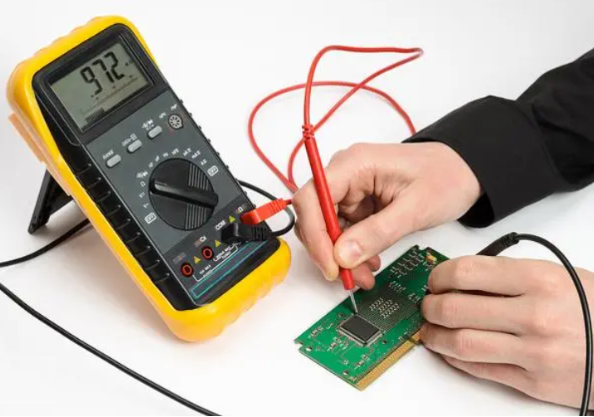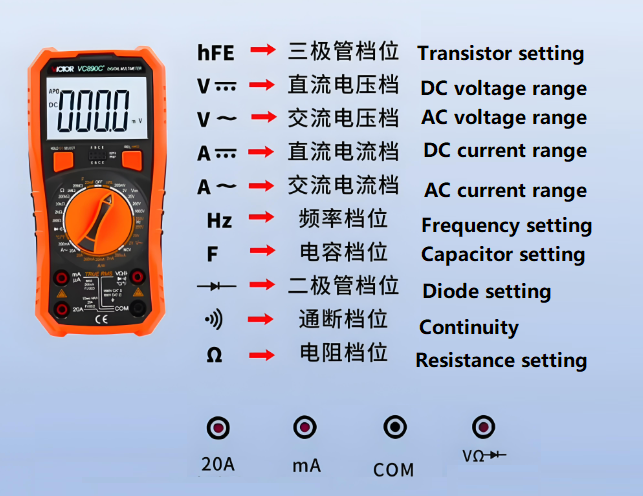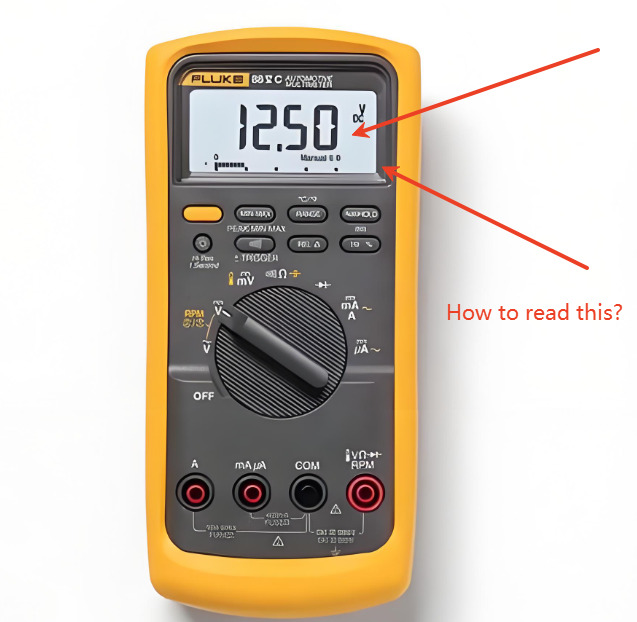If you have ever looked at a multimeter for the first time, the dial filled with symbols can look overwhelming. For beginners, these icons are often the most confusing part of the tool. Yet, understanding multimeter symbols is essential. Each symbol tells you what the meter is ready to measureāwhether itās voltage, current, resistance, continuity, or even more advanced functions like capacitance and frequency.
A multimeter is not just for professionals. Home users, electricians, and electronics enthusiasts all rely on it to diagnose problems, test components, and ensure safety in electrical work. If you donāt know what the symbols mean, you risk incorrect measurements or damaging the tool. This guide will walk you through the meanings of each symbol, how to use them step by step, and practical techniques for everyday testing.

What Do the Symbols Mean on a Multimeter?
Every multimeter has a rotating dial or digital menu with symbols. These represent the measurement modes. Once you learn them, the multimeter becomes much easier to use. Letās explore the most common:
| Symbol | Function | Notes / Quick Meaning |
| V~ | AC Voltage | Alternating current voltage |
| Vā or VDC | DC Voltage | Direct current voltage |
| A~ | AC Current | Alternating current measurement |
| Aā or ADC | DC Current | Direct current measurement |
| Ī© | Resistance | Measures in ohms |
| **Diode (▶ | ā)** | Diode Test |
| Continuity (🔔 or ~)) | Continuity | Beeps if circuit is complete |
| ** | ** | |
| Hz | Frequency | AC signal frequency in Hertz |
| mV | Millivolts | Small voltage measurements |
| Ī¼A / mA | Micro / Milli Amps | Small current ranges |
| Via Hole | Connection Check | All layer-interconnection testing (for PCBs) |
Here is a table make it more clear to understand each symbols in multimeter:

How to Use a Multimeter for Beginners?
If you are new to multimeters, donāt worry. Hereās a simple step-by-step approach that applies to most models:
1. Insert the probes correctly. The black lead always goes into the COM (common) port. The red lead goes into the port marked VĪ©mA for most tests. For high-current measurements, use the dedicated 10A or 20A port.
2. Turn the dial. Select the symbol for what you want to measure. For voltage, choose either AC (V~) or DC (Vā). For resistance, use Ī©.
3. Connect the probes. Place the tips on the two points of the circuit. For voltage, measure across a component. For current, insert the meter in series. For continuity, simply touch the two ends of the conductor.
4. Read the display. A digital multimeter will give you a number instantly. If the number seems unstable, try switching to another range.
Beginners should practice first on safe, low-voltage circuits. For example, test a battery in DC mode. This builds confidence before working with live AC circuits.
How to Read a Multimeter Display?
Multimeter displays show more than just numbers. Understanding the indicators will improve accuracy.

- Numeric Reading: The most obvious part. This is the value you are measuring.
- Unit Indicators: A letter or symbol like V, A, or Ī© appears beside the reading. It shows what the number represents. Display show V means this value is voltage, A means current, Ī© means resistance.
- Range Indicators: Some meters show prefixes like m (milli), Ī¼ (micro), or k (kilo). For example, 1.2kĪ© means 1,200 ohms.
- Additional Icons: Many meters have small indicators for functions such as āHold,ā āBattery Low,ā or āAuto Range.ā
If you use a manual range multimeter, you will also need to match the dial with the expected value. For example, if you measure a 9V battery, set the range above 9V (perhaps 20V). Auto-ranging multimeters save time by picking the correct range for you.
Which is AC and DC in Multimeter?
Multimeters clearly distinguish AC and DC with different symbols:
- AC is shown with V~ or A~. The wavy line matches the alternating pattern of AC signals.
- DC is shown with Vā or Aā. The straight and dashed line represents constant flow in one direction.
This distinction is critical. Using the DC mode on an AC outlet, for instance, wonāt give you a reliable reading. Worse, it may damage the meter if set incorrectly in current mode. Always confirm the source before selecting AC or DC.
What is a Good Reading for Continuity?
Continuity checks are among the easiest tests with a multimeter. When continuity exists, the resistance is close to zero. A good reading is usually:
- 0 to 2 ohms: Strong connection.
- Beeping sound: Most meters beep when continuity is present.
- OL or no reading: This indicates an open circuit, meaning no path for current.
For example, if you test a wire and hear a beep, it means the wire is intact. If there is no sound, the wire is broken. This test is handy for checking fuses, PCB traces, and connectors.
What is One Thing You Should Not Do When Using a Multimeter?
The most important safety rule: never measure resistance on a live circuit. Resistance testing requires the multimeter to send a small current through the circuit. If the circuit is powered, this can damage the meter or give false results.
Other things to avoid:
- Donāt exceed the current rating of the meter. Always check the specifications.
- Never switch modes while the probes are connected to a live circuit.
- Donāt touch probe tips when measuring high voltage.
- Safe habits keep both the user and the multimeter protected.
How Do I Know What Setting to Use on a Multimeter?
Choosing the right setting depends on the job. Here are some quick tips:
- Battery testing: Use Vā (DC voltage).
- Outlet testing: Use V~ (AC voltage).
- Checking a resistor: Use Ī©.
- Checking a fuse or wire: Use continuity (buzzer symbol).
- Testing a diode or LED: Use the diode mode.
If unsure, always start at the highest range for that setting, then lower it. This prevents overload and protects the meter. Auto-ranging models eliminate this step but itās still good practice to know.
How to Tell Voltage with a Multimeter?
Voltage is one of the most common tests. Hereās how to measure it:
- Set the multimeter to the correct voltage type (AC or DC).
- Connect the black probe to COM and red probe to VĪ©mA.
- Place probes across the component or source. For batteries, red goes to positive, black to negative.
- Read the display. Digital meters show the value directly; analog meters require reading the needle against the scale.
Voltage readings indicate the potential difference between two points in a circuit. For safety, confirm the voltage rating and type before connecting the probes.
How to Tell if Power is AC or DC with a Multimeter?
If you are unsure about the type of power, a multimeter can help identify it:
- Set the meter to AC voltage (V~). Measure the voltage.
- If the reading is zero, switch to DC (Vā).
- If a value appears in DC mode, the circuit uses direct current. If it appears in AC mode, itās alternating current.
Some multimeters have an auto AC/DC detection feature, showing the type automatically. This is useful for testing unknown sources safely.
For example, household outlets should give a reading in AC mode, while a battery will only show in DC mode. This method is reliable when testing unknown power supplies.
FAQs
1. What is the diode symbol on a multimeter used for?
It is used to test if current flows in one direction, mainly for diodes or LEDs.
2. Can I measure AC voltage on a battery?
No. Batteries provide DC only. The AC mode will show no useful reading.
3. Why is continuity testing important?
It checks if a circuit path is complete. This helps detect broken wires, damaged fuses, or faulty connections.
4. What does āOLā mean on a multimeter?
It stands for āopen loop.ā It indicates infinite resistance, meaning the circuit is broken.
5. Can I use the same probes for voltage and current tests?
Yes, but for high current, insert the red probe into the dedicated high-current port.
Learning multimeter symbols may seem like a small step, but it unlocks the real power of this tool. Once you know what each symbol means, testing voltage, current, resistance, and continuity becomes second nature. For beginners, starting with low-voltage DC tests is the best way to build confidence. With time, you can handle AC circuits, diodes, capacitors, and even frequency tests.
At EBest Circuit (Best Technology), we support customers with high-quality testing tools and professional PCB solutions. Our products come with strict quality control under ISO9001, ISO13485 for medical, IATF16949 for automotive, and AS9100D for aerospace standards. By combining competitive pricing, skilled engineering, and traceability through MES systems, we deliver reliable solutions for every customer. Whether you need PCBs or reliable testing tools, we provide everything with precision and care.


